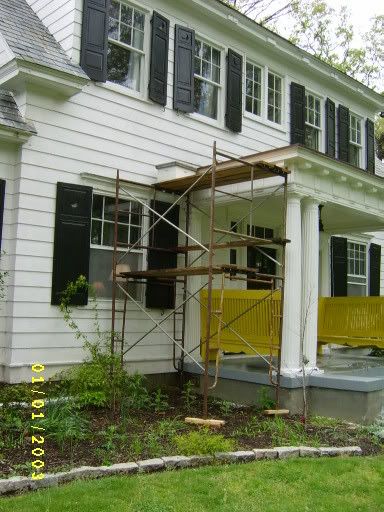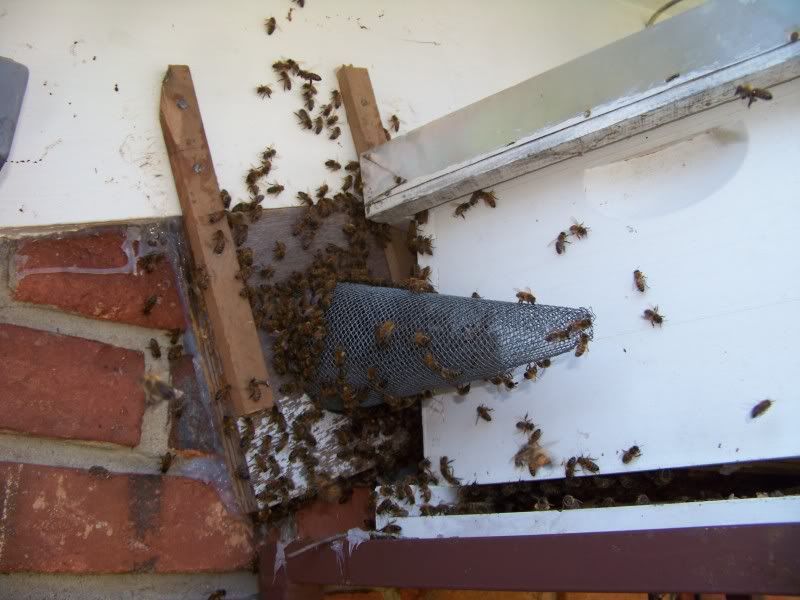I like to make a scouting trip to the trap out location and prepare
the area prior to setting the trap. I will use lumber, plastic,
silicone caulk, whatever will work, to reduce their entrance down to
one hole of approx. 2 inches, or 2 inches X not more than 3/4 inch, if
the opening is in a corner. After choosing or making the cone, I will
measure from the ground to the bottom of the cone. Then I can plan on
what I will use for the platform. This one had an initial entrance of 12 in. X 3 feet of rotted away wood. I crammed towels, burlap, and 2 cans of great stuff in it. Bees will eat through great stuff, if it is more than 3/8 in thick, or doesn't have a hard substance between layers of it.


On the day of the setup, I will remove a frame of brood, WITH EGGS,
from my chosen hive, and place it in a warm, shaded area, like the cab
of my truck. On site, I set the platform, level from side to side,
tilted slightly to the front. I then set the catch box where the
"porch" area can be slid against the plywood cone mount, an inch or
two below the bottom of the wire cone.I want the bees to walk from the
cone mount to the box, not fly. Next, I place the frame of brood in
the catch box, with one empty frame between it and the side of the box
next to the structure.I mark and predrill 4 holes in the cone mount in
a position needed to secure the mount and cone to the structure, over
the colony entrance. I run a circle of silicone caulk around the hole
in the cone mount, so it will compress and seal when I mount it to the
wall. If it cannot be mounted with screws, I will hold or prop it
tightly to let the silicone caulk dry enough to hold it in place.
If it is in a corner, I will tack 3/8 to 1/2 in. thick strips to the
bottom of the mount, on 2 or 3 sides, as needed, to allow the dees to
exit under the mount and into the cone. If the strips are used on a
corner trap, I will put the silicone on the strips. Next, I will run a
bead of silicone caulk around the outer edge of the mount to ensure a
solid seal.


At this time, I will stay in the area for 1 to 3 hours, talking to the
homeowner, showing them the bees are docile by putting my fingers
right up to them as they land at the base of the cone. "a returning
forager looking for the entrance will not sting". Doing my PR on all
honey bees, and looking for alternative entrances. If you can keep
them from finding another entrance for 48 hours, they doubtfully ever
will. If they do find one, you will find it is nearly impossible to
keep them from finding them from then on. The trapout will either be
greatly prolonged, or totally unfeasible to do. It is extremely
important to close all entrances the first time. I also instruct the
owner on what to look out for, depending on how comfortable he or she
is with the bees and to call me when they see certain signs. I return the next day for a 10 to 15 minute check, and if everything
is OK, I plan my next visit for one week later.
The position of the exit in the cone has no bearing on the trapout, as
we aren't catching the bees as they leave, but rather when they return
from the field, loaded with pollen and/or nectar. They will return to
the base of the cone, where they have always entered.
The relationship of the base of the cone to the entrance where the
brood frame sits is the detail you need to be conscious of, not the
exit.